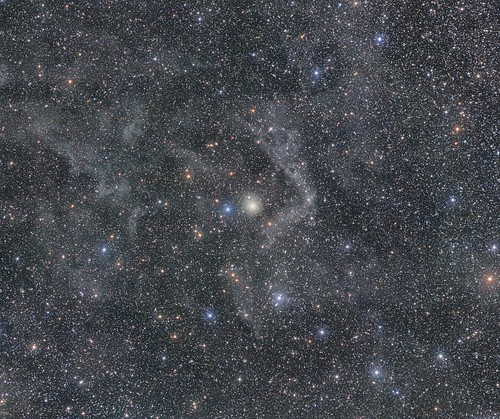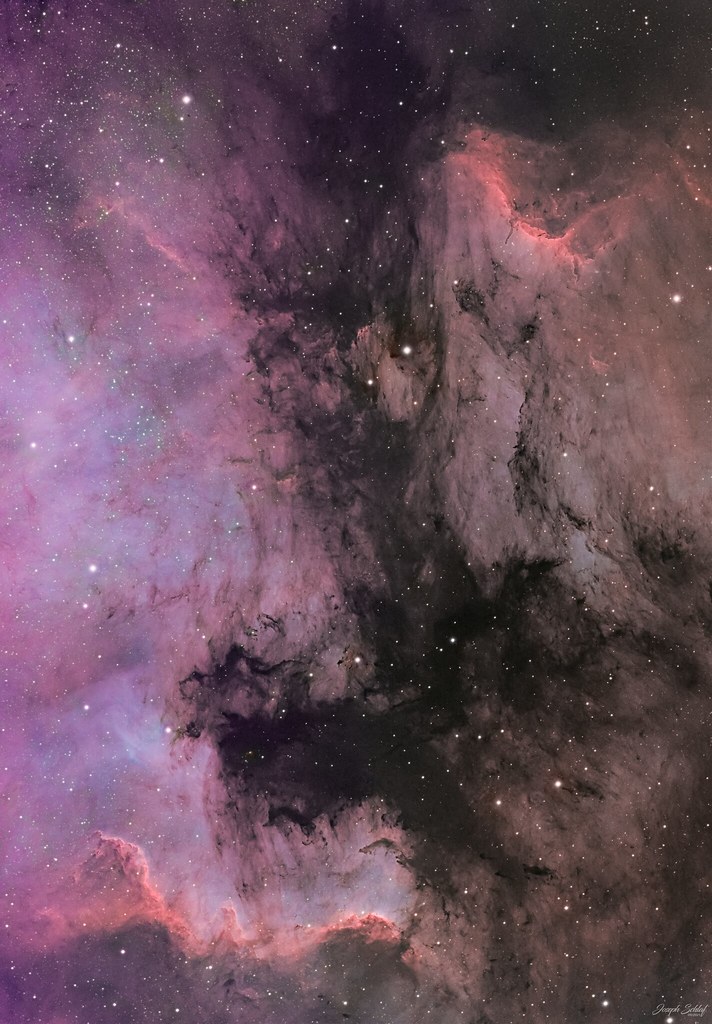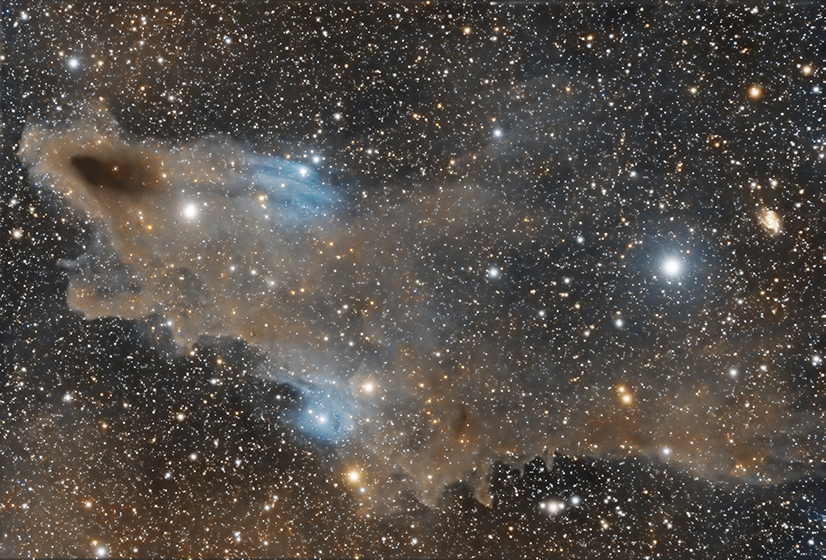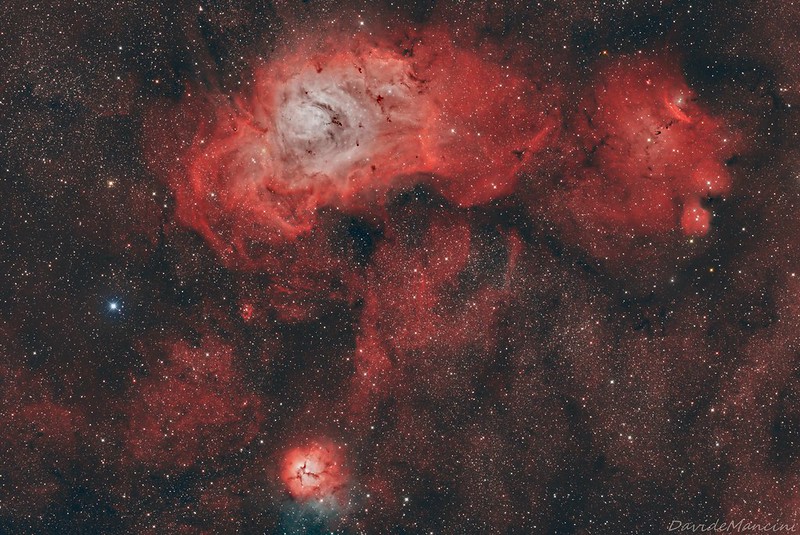Submissions: 2021 September
-
Manel Martín Folch
- Ensign
- Posts: 15
- Joined: Tue Jan 10, 2017 7:13 pm
Re: Submissions: 2021 September
11 hours of integration of the open star cluster NGC 6604 north of the Eagle Nebula form a set of contrasting colors in the middle of the Milky Way.
https://astrob.in/full/3xztcg/B/
https://astrob.in/full/3xztcg/B/
-
Juan Lozano
- Ensign
- Posts: 45
- Joined: Wed Feb 06, 2013 8:24 am
- Location: Elche (Alicante) Spain
- Contact:
Re: Submissions: 2021 September
Faint nebulae between Cassiopeia and Cepheus
http://observatorioelche.blogspot.com/2 ... eia-y.html
Copyright: Juan Lozano de Haro
http://observatorioelche.blogspot.com/2 ... eia-y.html
Copyright: Juan Lozano de Haro
-
PatrickWinkler
- Ensign
- Posts: 82
- Joined: Wed May 25, 2016 4:24 pm
- Location: Traiskirchen (Austria)
- Contact:
-
parkesburg_observatory
- Asternaut
- Posts: 5
- Joined: Thu Apr 22, 2021 3:35 pm
Re: Submissions: 2021 September
Hello and thank you for allowing me to post. Towards the end of August and early September, I captured this narrowband image of Melotte 15 from my backyard using a Celestron Edge HD11.
I have about 22 hours of integration time, stacked and processed in Pixinsight as SHO with additional adjustments to drop the overall green cast from the Ha data assigned to the green channel.
Full resolution image can be found here https://www.astrobin.com/n2rwc1/C/
Thank you!
Steve
Instagram: https://www.instagram.com/parkesburg_observatory/
Astrobin: https://www.astrobin.com/users/parkesburg_observatory/
Full resolution image can be found here https://www.astrobin.com/n2rwc1/C/
Thank you!
Steve
Instagram: https://www.instagram.com/parkesburg_observatory/
Astrobin: https://www.astrobin.com/users/parkesburg_observatory/
-
Iaffaldano Giuseppe Carmine
- Ensign
- Posts: 54
- Joined: Sun Jun 18, 2017 10:13 am
- Location: TARANTO
Re: Submissions: 2021 September
M15 in large field and IFN
 M15 in IFN of Pegaso - LRGB with Sbig 16200 and Spacecat 51 by gc.iaffaldano, su Flickr
M15 in IFN of Pegaso - LRGB with Sbig 16200 and Spacecat 51 by gc.iaffaldano, su Flickr
Copyright Iaffaldano GC.
 M15 in IFN of Pegaso - LRGB with Sbig 16200 and Spacecat 51 by gc.iaffaldano, su Flickr
M15 in IFN of Pegaso - LRGB with Sbig 16200 and Spacecat 51 by gc.iaffaldano, su FlickrCopyright Iaffaldano GC.
-
markh@tds.net
- Science Officer
- Posts: 117
- Joined: Wed Oct 03, 2012 7:44 pm
Re: Submissions: 2021 September
Messier 22
Copyright: Mark Hanson
Messier 22 or M22, also known as NGC 6656, is an elliptical globular cluster of stars in the constellation Sagittarius, near the Galactic bulge region. It is one of the brightest globulars visible in the night sky.
Taken with PlaneWave 24” CDK at SWOS in Chile.
Unfortunately the colors and resolution here in this small image did not turn out the best but the full version is a must look, its quite impressive and can be seen here:
https://www.hansonastronomy.com/m22-globular-cluster
Thank you,
Mark Hanson
Copyright: Mark Hanson
Messier 22 or M22, also known as NGC 6656, is an elliptical globular cluster of stars in the constellation Sagittarius, near the Galactic bulge region. It is one of the brightest globulars visible in the night sky.
Taken with PlaneWave 24” CDK at SWOS in Chile.
Unfortunately the colors and resolution here in this small image did not turn out the best but the full version is a must look, its quite impressive and can be seen here:
https://www.hansonastronomy.com/m22-globular-cluster
Thank you,
Mark Hanson
- the_astronomy_enthusiast
- Ensign
- Posts: 98
- Joined: Fri Apr 16, 2021 10:16 pm
- Contact:
Re: Submissions: 2021 September

The Antennae Galaxies from Hubble by William Ostling, on Flickr
A full write-up is visible here: https://theastroenthusiast.com/the-ante ... om-hubble/
The galaxies in this image — also known as NGC 4038 and NGC 4039 — are locked in a deadly embrace. Once normal, sedate spiral galaxies like the Milky Way, the pair have spent the past few hundred million years sparring with one another. This clash is so violent that stars have been ripped from their host galaxies to form a streaming arc between the two. In wide-field images of the pair the reason for their name becomes clear — far-flung stars and streamers of gas stretch out into space, creating long tidal tails reminiscent of antennae.
This new image of the Antennae Galaxies shows obvious signs of chaos. Clouds of gas are seen in bright pink and red, surrounding the bright flashes of blue star-forming regions — some of which are partially obscured by dark patches of dust. The rate of star formation is so high that the Antennae Galaxies are said to be in a state of starburst, a period in which all of the gas within the galaxies is being used to form stars. This cannot last forever and neither can the separate galaxies; eventually the nuclei will coalesce, and the galaxies will begin their retirement together as one large elliptical galaxy.
Website: https://theastroenthusiast.com/
Instagram: https://www.instagram.com/the_astronomy_enthusiast/
-
lmanzanero
- Ensign
- Posts: 10
- Joined: Fri Sep 21, 2018 4:26 pm
Re: Submissions: 2021 September
The Milkyway in the Huasteca Canyon, south of Monterrey, México on September 6th, 2021. North is at the top, so the light of the nearby city dominates and washes the sky on that direction. 360 degree mosaic made from 21 individual pictures.https://www.facebook.com/ljmanzaneroAst ... 0353849168
https://www.instagram.com/ljmanzanero/
https://www.instagram.com/ljmanzanero/
-
astrojoetography
- Asternaut
- Posts: 8
- Joined: Wed Sep 08, 2021 6:28 pm
Re: Submissions: 2021 September
 North America & Pelican in HaGO by Joe Schlaf, on Flickr
North America & Pelican in HaGO by Joe Schlaf, on FlickrImage of Pelican & North America Nebulae including the Cygnus wall. This image was taken with 2 narrowband filters (Ha & OIII) and one broadband filter (Green). The HaGO palette is created by combining the three channels to an RGB image with Ha representing Red and OIII representing B. HaGO is intended to represent a more accurate representation of the natural color of the nebula than the SHO (Hubble palette) while benefiting from the pros of narrowband imaging.
Image data collected in Michigan over the months of May, June, and July. This image represents ~17.5 hours of integration time.
Photographer: Joe Schlaf
@astrojoetography
Re: Submissions: 2021 September
The Bubble Nebula is an emission nebula. The "bubble" is created by the stellar wind from a massive hot young central star, The nebula is near a giant molecular cloud which contains the expansion of the bubble nebula while itself being excited by the hot central star, causing it to glow.
Presented here in a modified SHO palette.
Also the first fully unguided image with the AP1100GTO CP4 mount using a PE curve and no-encoders.
Average sub Eccentricity was 0.45 which I was very happy with, the stacked image was 0.39.
Imaging telescopes or lenses: Planewave CDK 12.5
Imaging cameras: QHYCCD 268M
Mounts: Astro-Physics AP1100 GTO CP4
Focal reducers: Planewave Instruments 0.66x Reducer
Dates:Sept. 2, 2021 , Sept. 3, 2021 , Sept. 4, 2021
Frames:
Chroma 3nm H⍺: 119x300" (9h 55') bin 1x1
Chroma 3nm Sii: 74x300" (6h 10') bin 1x1
Chroma 3nm OIII : 78x300" (6h 30') bin 1x1
Integration: 22h 35'
Bortle Dark-Sky Scale: 6.00
Pixel scale: 0.656 arcsec/pixel
Presented here in a modified SHO palette.
Also the first fully unguided image with the AP1100GTO CP4 mount using a PE curve and no-encoders.
Average sub Eccentricity was 0.45 which I was very happy with, the stacked image was 0.39.
Imaging telescopes or lenses: Planewave CDK 12.5
Imaging cameras: QHYCCD 268M
Mounts: Astro-Physics AP1100 GTO CP4
Focal reducers: Planewave Instruments 0.66x Reducer
Dates:Sept. 2, 2021 , Sept. 3, 2021 , Sept. 4, 2021
Frames:
Chroma 3nm H⍺: 119x300" (9h 55') bin 1x1
Chroma 3nm Sii: 74x300" (6h 10') bin 1x1
Chroma 3nm OIII : 78x300" (6h 30') bin 1x1
Integration: 22h 35'
Bortle Dark-Sky Scale: 6.00
Pixel scale: 0.656 arcsec/pixel
-
Rodolphe lacroix
- Asternaut
- Posts: 1
- Joined: Thu Sep 09, 2021 11:49 am
Re: Submissions: 2021 September
Hi,
here an image of IC1396A (The Elephant's Trunk Nebula) I've taken it between september the 1st and september the sixth in brittany, France.
It's my first SHO picture with 3nm narrowband filters. I've used a TOA130NFB on 10micron 1000HPS mount. The astrocamera was a ZWO2600MM.
The Elephant's Trunk Nebula is a concentration of interstellar gas and dust within the much larger ionized gas region IC 1396 located in the constellation Cepheus about 2,400 light years away from Earth. The piece of the nebula shown here is the dark, dense globule IC 1396A; it is commonly called the Elephant's Trunk nebula because of its appearance at visible light wavelengths, where there is a dark patch with a bright, sinuous rim.
IC1396A
https://www.flickr.com/photos/127004951@N06/
Copyright: Rodolphe Lacroix Technical data :
S : 65x5min
H : 65x5min
O : 90x5min
Total : 18,5 hours
TOA130 NFB with field flattener (1000mm focal) / mount 10micron 1000HPS
Full jpeg version : https://live.staticflickr.com/65535/514 ... 1f13_k.jpg
Best regards
Rodolphe Lacroix
here an image of IC1396A (The Elephant's Trunk Nebula) I've taken it between september the 1st and september the sixth in brittany, France.
It's my first SHO picture with 3nm narrowband filters. I've used a TOA130NFB on 10micron 1000HPS mount. The astrocamera was a ZWO2600MM.
The Elephant's Trunk Nebula is a concentration of interstellar gas and dust within the much larger ionized gas region IC 1396 located in the constellation Cepheus about 2,400 light years away from Earth. The piece of the nebula shown here is the dark, dense globule IC 1396A; it is commonly called the Elephant's Trunk nebula because of its appearance at visible light wavelengths, where there is a dark patch with a bright, sinuous rim.
IC1396A
https://www.flickr.com/photos/127004951@N06/
Copyright: Rodolphe Lacroix Technical data :
S : 65x5min
H : 65x5min
O : 90x5min
Total : 18,5 hours
TOA130 NFB with field flattener (1000mm focal) / mount 10micron 1000HPS
Full jpeg version : https://live.staticflickr.com/65535/514 ... 1f13_k.jpg
Best regards
Rodolphe Lacroix
Last edited by Rodolphe lacroix on Thu Sep 09, 2021 3:24 pm, edited 1 time in total.
Re: Submissions: 2021 September
LDN 673 in Aquila
https://www.mauricetoet.nl/DeepSky/i-7Gg6d45/A
Copyright: Maurice Toet LDN 673 is part of a highly fractured dense cloud of dust and gas that silhouettes against the Milky Way's faint starlight in the constellation of Aquila.
https://www.mauricetoet.nl/DeepSky/i-7Gg6d45/A
Copyright: Maurice Toet LDN 673 is part of a highly fractured dense cloud of dust and gas that silhouettes against the Milky Way's faint starlight in the constellation of Aquila.
-
barretosmed
- Science Officer
- Posts: 482
- Joined: Thu Oct 12, 2017 6:04 pm
Re: Submissions: 2021 September
THE GLOBULAR CLUSTER MESSIER 107
Discovered in 1782 by Pierre Méchain, French astronomer and colleague of Charles Messier, M107 was the last Messier object to be found, located in the constellation Ophiuchus, it lies close to the galactic plane at a distance of 20,000 light-years from Earth. It has the designation NGC 6171 in the New General Catalog.
The globular cluster apparently presents more obscured regions, unusual for such astronomical objects, it is densely concentrated in a volume that is only about 20x the distance between our Sun and its closest stellar neighbor.
Best details:
https://www.astrobin.com/full/4ym1o9/0/
EQUIPMENTS:
ZWO ASI 6200MC PRO COLED
Espirit 150mm
45 x 100sec
Date: 08/06/2021
Location: Jales-SP-Brazil
Copyright: Fernando Oliveira de Menezes
E-mail: Barretosmed@hotmail.com
Discovered in 1782 by Pierre Méchain, French astronomer and colleague of Charles Messier, M107 was the last Messier object to be found, located in the constellation Ophiuchus, it lies close to the galactic plane at a distance of 20,000 light-years from Earth. It has the designation NGC 6171 in the New General Catalog.
The globular cluster apparently presents more obscured regions, unusual for such astronomical objects, it is densely concentrated in a volume that is only about 20x the distance between our Sun and its closest stellar neighbor.
Best details:
https://www.astrobin.com/full/4ym1o9/0/
EQUIPMENTS:
ZWO ASI 6200MC PRO COLED
Espirit 150mm
45 x 100sec
Date: 08/06/2021
Location: Jales-SP-Brazil
Copyright: Fernando Oliveira de Menezes
E-mail: Barretosmed@hotmail.com
-
jordan.patrick
- Asternaut
- Posts: 1
- Joined: Tue Sep 07, 2021 7:07 pm
Re: Submissions: 2021 September
My first submission!
IC434 and NGC2024 in Orion
Stellarvue SVT80
QSI683WSG
Mach1 GTO
L:20x300
R:13x300
G:13x300
B:13x300
Full resolution can be found here: https://live.staticflickr.com/65535/514 ... d3c0_k.jpg
IC434 and NGC2024 in Orion
Stellarvue SVT80
QSI683WSG
Mach1 GTO
L:20x300
R:13x300
G:13x300
B:13x300
Full resolution can be found here: https://live.staticflickr.com/65535/514 ... d3c0_k.jpg
-
diy_nasa
Re: Submissions: 2021 September
Heart of The Heart
https://www.instagram.com/diy_nasa/
Copyright: Abraham C. Jones
https://cdn.astrobin.com/thumbs/5QXdfkF ... AWF7vj.jpg
August 1st in West Virginia Backyard
ASI294MM Pro
24x300 Astrodon Oiii
24x300 Astrodon HA
24x300 Astrodon Sii
https://www.instagram.com/diy_nasa/
Copyright: Abraham C. Jones
https://cdn.astrobin.com/thumbs/5QXdfkF ... AWF7vj.jpg
August 1st in West Virginia Backyard
ASI294MM Pro
24x300 Astrodon Oiii
24x300 Astrodon HA
24x300 Astrodon Sii
Last edited by bystander on Thu Sep 09, 2021 10:44 pm, edited 1 time in total.
Reason: Please, no hot links to images > 500 kb
Reason: Please, no hot links to images > 500 kb
-
Guest
Re: Submissions: 2021 September
Last edited by bystander on Fri Sep 10, 2021 5:39 pm, edited 1 time in total.
Reason: All <img> tags require an image url not a page url
Reason: All <img> tags require an image url not a page url
-
aignerastro
- Asternaut
- Posts: 7
- Joined: Wed Apr 21, 2021 11:53 pm
Re: Submissions: 2021 September
The Dark Shark Nebula
http://www.aignerastro.com
Copyright: Jay Aigner LDN1235, The Dark Shark Nebula, shot at Cherry Springs State Park in Pennsylvania. It’s about a 12 hour round trip from my house, but I’d drive 10x that far to be able to shoot this incredible target in dark skies. This was shot back in June of this year.
This is about 8 hours of total integration time in L, R, G, B with my monochrome ZWO 294M camera and 115MM Meade refractor. EQ6R mount, ZWO EAF, ZWO OAG, and Astronomik LRGB Deep Sky filters.
http://www.aignerastro.com
Copyright: Jay Aigner LDN1235, The Dark Shark Nebula, shot at Cherry Springs State Park in Pennsylvania. It’s about a 12 hour round trip from my house, but I’d drive 10x that far to be able to shoot this incredible target in dark skies. This was shot back in June of this year.
This is about 8 hours of total integration time in L, R, G, B with my monochrome ZWO 294M camera and 115MM Meade refractor. EQ6R mount, ZWO EAF, ZWO OAG, and Astronomik LRGB Deep Sky filters.
- Robin_Onderka
- Ensign
- Posts: 47
- Joined: Sat Mar 07, 2020 6:54 pm
Re: Submissions: 2021 September
Relaxation under the starry sky
Copyright: www.instagram.com/robin_onderka
--
Two friends I first met about half a year ago in the same place. Both passionate photographers who travel to Grun take pictures of the stars. Well, this meeting was very rare, but they shared the place and I then misused them as models in the photo
My goal was a clear, full-sky panorama at 35mm from the tracker for the highest quality photo. Such a novelty, which I did not dare to go into last night.
.
Canon 6Da + Sigma 35mm f / 1.4 + Skywatcher Star Adventurer + tripod
20 "> 25"> 30 "(from horizon to zenit due to darker sky)
f/2.5
ISO 3200
The landscape is 30 "f/2.5 ISO 3200 with the tracker off and in some places an extra photo for exposure bracketing.
Both panoramas blended together in Photoshop at 1:1 position.
Location: Staré Hamry, Czech Republic
 Relaxation under the starry sky by Robin Onderka, on Flickr
Relaxation under the starry sky by Robin Onderka, on Flickr
Copyright: www.instagram.com/robin_onderka
--
Two friends I first met about half a year ago in the same place. Both passionate photographers who travel to Grun take pictures of the stars. Well, this meeting was very rare, but they shared the place and I then misused them as models in the photo
My goal was a clear, full-sky panorama at 35mm from the tracker for the highest quality photo. Such a novelty, which I did not dare to go into last night.
.
Canon 6Da + Sigma 35mm f / 1.4 + Skywatcher Star Adventurer + tripod
20 "> 25"> 30 "(from horizon to zenit due to darker sky)
f/2.5
ISO 3200
The landscape is 30 "f/2.5 ISO 3200 with the tracker off and in some places an extra photo for exposure bracketing.
Both panoramas blended together in Photoshop at 1:1 position.
Location: Staré Hamry, Czech Republic
 Relaxation under the starry sky by Robin Onderka, on Flickr
Relaxation under the starry sky by Robin Onderka, on Flickr-
filipgloria
Re: Submissions: 2021 September
This picture is my second ever on my new 1600mm pro. The elephant trunk nebula is one of the most beautiful objects out there in my opinion and this is my rendition of it.
This was captured with my 1600mm pro and ZWO 7nm narrowband (SHO) and processed in the Hubble palette. No calibration files.
Date captured: 7th and 10th of September
Scope: Sky-Watcher 150/750 PDS
Place: My aunts balcony just outside of Stockholm in a bortle 7-8 sky.
Ha: 5min x 12 + 10min x 14
SII: 5min x 10
OIII: 5min x 7
Processed in Pixinsight and GIMP
Photography by: Filip Gloria
Elephant Trunk Nebula in SHO
https://storage.googleapis.com/dso-brow ... iginal.jpg
Copyright: Filip Gloria
https://storage.googleapis.com/dso-brow ... iginal.jpg
This was captured with my 1600mm pro and ZWO 7nm narrowband (SHO) and processed in the Hubble palette. No calibration files.
Date captured: 7th and 10th of September
Scope: Sky-Watcher 150/750 PDS
Place: My aunts balcony just outside of Stockholm in a bortle 7-8 sky.
Ha: 5min x 12 + 10min x 14
SII: 5min x 10
OIII: 5min x 7
Processed in Pixinsight and GIMP
Photography by: Filip Gloria
Elephant Trunk Nebula in SHO
https://storage.googleapis.com/dso-brow ... iginal.jpg
Copyright: Filip Gloria
https://storage.googleapis.com/dso-brow ... iginal.jpg
Last edited by bystander on Sat Sep 11, 2021 2:34 pm, edited 1 time in total.
Reason: Please, no hot links to images > 500 kb
Reason: Please, no hot links to images > 500 kb
Re: Submissions: 2021 September
https://drive.google.com/file/d/1JUwgqk ... sp=sharing
95 5 min exposures using Redcat 51 and ZWOASI294 MC pro. Take in Pennsylvania over 3 night (8-11 September)
95 5 min exposures using Redcat 51 and ZWOASI294 MC pro. Take in Pennsylvania over 3 night (8-11 September)
Re: Submissions: 2021 September
Large Solar Prominence - September 11, 2021
https://www.deepskyobjects.com/Sun/Sun_210911_b.asp
Copyright: Behyar Bakhshandeh, Carlsbad, CA
http://www.deepskyobjects.com/
https://www.deepskyobjects.com/Sun/Sun_210911_b.asp
Copyright: Behyar Bakhshandeh, Carlsbad, CA
http://www.deepskyobjects.com/
Re: Submissions: 2021 September
Hello folks here M8_M20
Telescope: SharpStar 150 f2,8
Guide Scope:Evoguide
Mount : Skywatcher HEQ5
Imaging camera: ZWO 2600MC
Guiding camera: ZWO 290 MC
Filters: Idas NBZ
Plate solving: SGpro
Imaging software: Sgpro
Guiding software: PHD2
Processing software: Pixinsight
Lpro 90X120s exposure@100Gain
Integration: 3 hrs
Copyright:Davide Mancini
Telescope: SharpStar 150 f2,8
Guide Scope:Evoguide
Mount : Skywatcher HEQ5
Imaging camera: ZWO 2600MC
Guiding camera: ZWO 290 MC
Filters: Idas NBZ
Plate solving: SGpro
Imaging software: Sgpro
Guiding software: PHD2
Processing software: Pixinsight
Lpro 90X120s exposure@100Gain
Integration: 3 hrs
Copyright:Davide Mancini
Re: Submissions: 2021 September
 Soul Nebula by Dave & telescope, on Flickr
Soul Nebula by Dave & telescope, on FlickrSoul Nebula IC 1848
Location: Mayhill, NM
Telescope: Takahashi 180ED
Data: 4,3.5, 4.5 hours RGB
Thanks for looking!
Dave Doctor
Re: Submissions: 2021 September
 Wizard Nebula | NGC7380 by Garrick Walles, on Flickr
Wizard Nebula | NGC7380 by Garrick Walles, on FlickrFirst attempts at proper narrow band imaging with a mono camera. Image as taken in Sidcup, UK, Bortle 8 zone.
Imaging telescopes or lenses: William Optics GT71 II APO
Imaging cameras: ZWO ASI 294MM Pro (cooled) ASI294MM PRO
Mounts: Skywatcher HEQ5 PRO (belt modification)
Guiding telescopes or lenses: William Optics 50/200 GuideScope
Guiding cameras: ZWO ASI120MM-S ASI 120MM-S
Focal reducers: Hotech 2" SCA Self-Centering Field Flattene Hotech 2" SCA Field Flattener
Software: PixInsight 1.8.7 Ripley PixInsight · Asi Air for IOS
Filters: Baader Ha, OIII, SII 1.25 inch
Accessory: ZWO ASI Air
Dates:Aug. 28, 2021
Frames:Baader Ha, OIII, SII 1.25 inch: 242x180" (12h 6') (gain: 120.00) -10C bin 2x2
Integration: 12h 6'
Darks: 41
Flats: 41
Flat darks: 41
Avg. Moon age: 20.54 days
Avg. Moon phase: 66.76%
Bortle Dark-Sky Scale: 8.00






